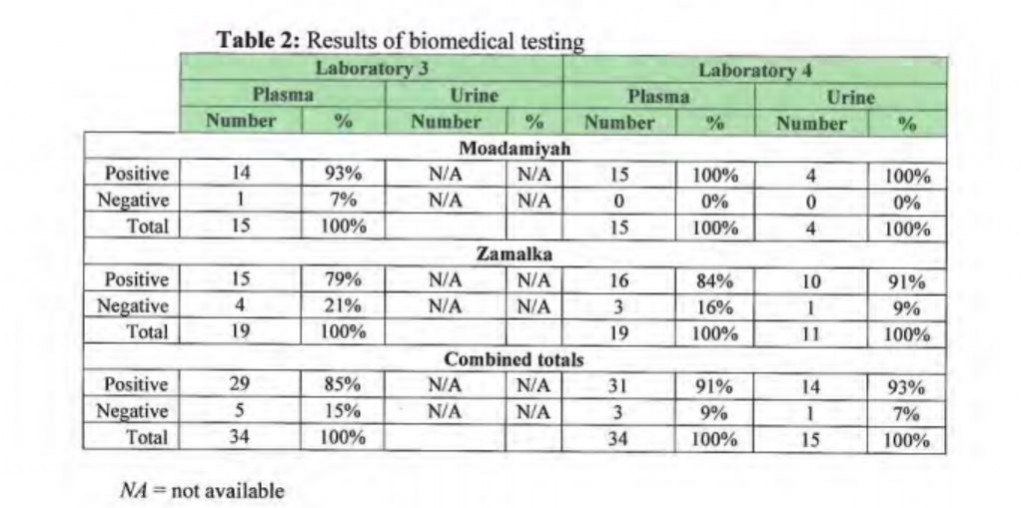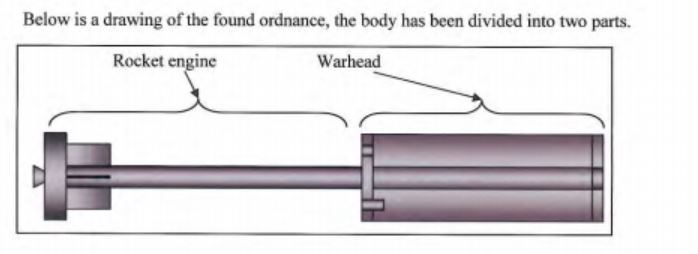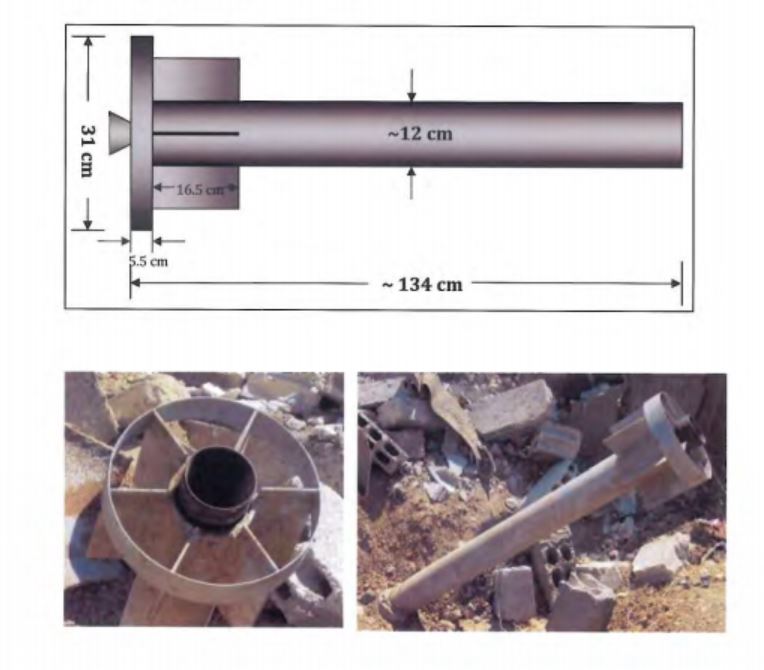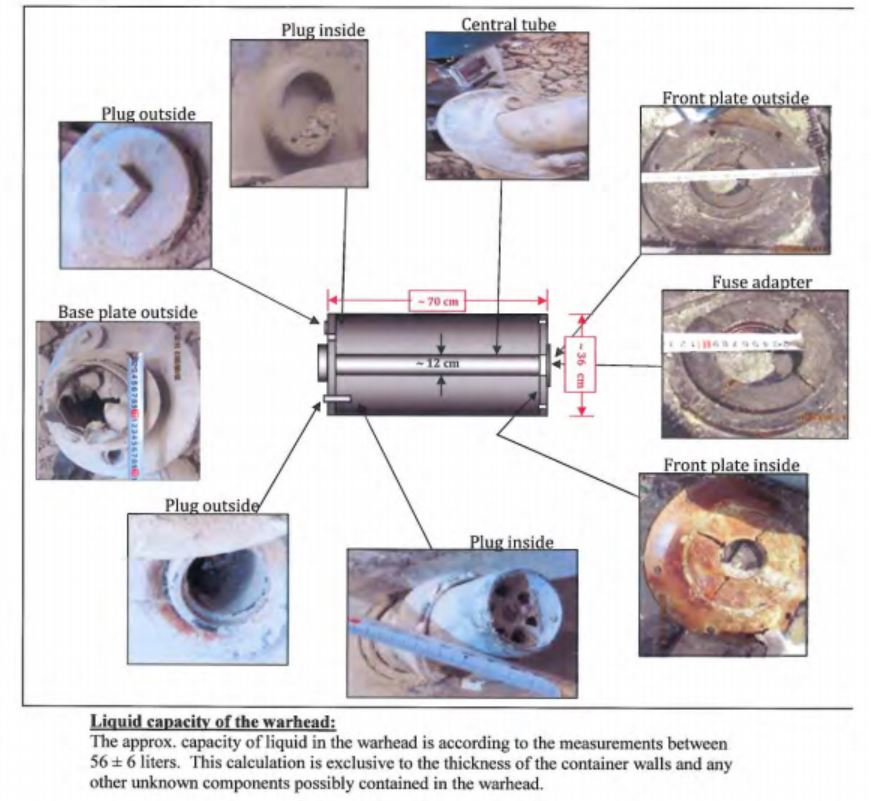Working Thread: UN Chemical Weapon Report on Syria Released
The UN has finally released its report (pdf) on the analysis of both human and environmental samples relating to the chemical weapon attack in the Ghouta area of Syria on August 21. The report finds unequivocal evidence of sarin in blood, urine and environmental samples.
A total of 36 primary victims and first responders who were exposed were interviewed. Sixteen of them were from Moadamiyah and twenty were from Zamalka. Seventy eight percent of them lost consciousness, 61% had difficulty breathing and 42% had blurred vision. Thirty four of the thirty six had blood samples taken (two refused) and 15 showing the most severe symptoms submitted urine samples. The materials were sent to two separate laboratories for analysis:
Rockets that could have delivered the chemical agent were found at some sites. At least one was capable of carrying up to 50 liters of liquid. Schematic of intact rocket:
The engine end was exposed at the impact site:
The warhead:
But of course, these inspections came on August 26 in Moadamiyah and August 28 and 29 in Zamalka, so 5 to 8 days passed between the attack and the analysis. The key point to keep in mind when considering the rocket evidence is this:
People had plenty of time to move things around before the UN inspectors came onto the site. The possibility that evidence has been manipulated cannot be ruled out.
My first impressions from the report are that it is without question that the people interviewed and who submitted samples were indeed exposed to sarin. How it was delivered is another question entirely. Rockets were found in the vicinity where people were exposed and environmental samples, including from the rockets themselves, showed evidence of sarin, but it is impossible to conclude the rockets definitely delivered the sarin. It is impossible to rule out sarin being put onto the rocket debris after impact.
I’ve only skimmed the report, please consider this a working thread and share any findings in comments.







Jim, did the reports go into any detail about the type of sarin used? Was it the military-grade rather than “kitchen” sarin?
I’m surprised by the condition of the rockets. The inside of the front base plate looks badly corroded, looking like rust. The tail fins of the motor section also looks corroded. The rocket as a whole looks highly weathered; my first impression was of something heated by a fire or explosion, but on second thought, that seemed unnecessary to simply leak out a gas. This raises a flag in my mind because any military ordinance would be painted and stored to avoid corrosion, not only to prevent misfires and duds, but just to keep up that orderly appearance the brass like to see.
@OmAli: That isn’t clear. They mention finding sarin and sarin breakdown products in the final appendix, where get some of the details of the chemical analysis of environmental samples. They don’t describe the “other interesting chemicals found” in terms of why they are interesting. The text also vaugely refers to “stabilizers” without saying which chemical(s) they are referring to.
As important is the question not just of how but by whom was it delivered. At the start of the Syrian Civil War, and right after Libya, there was a lot of discussion about chemical weapons going missing or being handed over to local commanders for use. Indeed as you noted Macy this was one of the original arguments for is becoming involved, keeping this out of the hands of the Jihadis.
As I understand it the U.S. Intel data does not even guarantee that the weapons were fired by government troops let alone on Assad’s orders. Nor have I seen any such discussion from the U.N. report.
@OmAli: But of course folks are going further in discussions with WaPo
But none of that analysis appears in the report itself, nor, as far as I can tell, does any data to support that conclusion.
http://www.washingtonpost.com/world/middle_east/kerry-un-will-enforce-deal-to-rid-syria-of-chemical-weapons/2013/09/16/0f1d9bf6-1eb6-11e3-94a2-6c66b668ea55_story.html?hpid=z5
how hard would it be to launch one of these? it looks like it is about 4 feet long. have i got that right? any comparisons to the march 19th attack in aleppo and whether something similar was used in that attack?
i read over at moon of alabama – “The UN report on chemical stuff used in the Damascus suburb Ghouta on August 21 finds (pdf) that Sarin has been used which was probably distributed by unguided 140mm rockets.” “unguided” doesn’t imply a level of sophistication..
http://www.moonofalabama.org/2013/09/three-current-news-items-on-syria.html#comments
@bell: Yeah, since it’s unguided, the rocket is simply aimed by controlling the direction the nose of the rocket faces and the amount the nose is elevated above horizontal. Then, it’s just Newtonian mechanics similar to freshman physics where the force of the rocket motor is working against gravity. Complicating factors for the calculation are windspeed and the frictional drag of the rocket. Unguided in this since means there is no course correction or homing once the rocket is in flight. The math also would get a bit fuzzier if the fuel doesn’t burn evenly. Also, with a rocket of this size, the weight of the fuel also complicates the math for predicting where the rocket will land.
The projectiles whose images are shown here are in remarkable good condition for having been allegedly launched into the air, flying several miles, and burying itself in rubble. As noted above, they should have paint on them, probably in specific combinations of colors to designate (A) it’s a chemical weapon and (B) what the active agent is. All I see is rust and dirt.
More to the point, chemical weapons (particularly artillery rockets like these are made to appear to be) contain a bursting charge – a couple pounds of high explosive – connected to a (mechanical) fuze that’s designed to set off the bursting charge. The planned procedure is that the rocket lands on the fuze, the fuze functions and sets off the bursting charge and then the bursting charge explodes and ruptures the tank full of chemical agent, dispersing it in all directions. Imagine, if you will, taping an M-80 firecracker to a can of soda – soda everywhere. There is often a second fuze, sometimes connected to the rocket motor, so as to set off the bursting charge in the event the first fuze doesn’t go off.
The pictures we see here are of unexploded rockets buried in rubble. There are no evident ruptures and dents and no signs of a bursting charge explosion. Indeed, it’s open to question whether there was any fuze screwed into the fuze well.
So, we’re left with a couple possibilities. One is that the rockets pictured were launched with fuzes, flew, landed, buried themselves in the ground, the fuzes didn’t function, and then have been lying there, half-buried. These are called “duds”. Duds are extremely dangerous. They are malfunctioning pieces of machinery. Anything, even just the passage of time, can result in the malfunction resolving itself and the remaining step(s) to explosion taking place. If the inspectors were mucking around duds, they’re candidates for the Darwin Awards. If the rocket were to explode, they would be subject to being splashed with large quantities of nerve agent when a pinhead’s worth is enough to kill.
The next possibility is that there never was a fuze inserted, but the rocket was still launched. If that’s the case, then there is a strong possibility the launch was unauthorized. Sensible military organizations would impose controls on fuzes to prevent rogue personnel from setting off these weapons. But a launched rocket would show more damage than appears here. Going up and looking at a launched-and-landed chemical rocket would remain extremely dangerous because there’s a strong possibility any agent would leak.
The next possibility is that there never was a fuze inserted and the rocket was not launched but instead was buried there manually. This would account for the apparent lack of damage. It would also account for the relative freedom of coming up and looking at the rocket which the pictures indicate. An undamaged rocket buried in the ground by hand would be highly unlikely to have leaked.
All these possibilities so far assume the rocket was loaded with chemical agent if/when it was fired or buried in the ground. The general mode of constructing these weapons is to make them only strong enough to withstand the forces encountered in launch and powered and gliding flight, since the intent is for them to burst open on impact. So, the agent container is generally a simple can, relatively weak and lightly constructed. If there was no chemical agent in the rocket, i.e., it was empty, it would not have flown well and would have been far more likely to have bounced and skittered along the ground rather than burying itself in the ground.
On the other hand, it’s possible the rocket was filled with something other than chemical agent. If the rocket had been filled with agent previously, someone could have emptied it and replaced the agent with something inert, like water. If the rocket was empty, and intended to be filled with agent prior to firing, then someone could have just as easily filled it with something inert and used the agent elsewhere.
So, we have unpainted unexploded munitions half-buried in the ground which may never have been fired at all, which may or may not have fuzes in them, and which may or may not ever have had chemical agent in them.
I agree about being very cautious with the report data. That said, the it’s nice to finally have some data. I was initially skeptical of the shadowy reports regarding chem rockets from Syrian bases, but I think the UN report firms that case up at bit.
To me, it looked like the UN was pretty conservative with their ballistic data on two of the 5 impact sites (1 and 4). It looks like they were aware of the problem of after-event disturbance. I’ve plotted the resulting tracks here https://twitter.com/Casual_Obs/status/379684555835604992 and here: https://twitter.com/Casual_Obs/status/379685054387326976
The tracks suggest the point of origin may well have been the sprawling mil. base West of the city.
Jim – it is never appropriate to exploit a dubious event to talk about gun control, no more than it is for the USG to try to exploit dubiously-sourced CW attacks to start a war. Carney and the rest of the WH got the message from last week’s recalls in Colorado, loud and clear.
The one thing we know about today at the Navy Yard is that someone performed criminal acts with a weapon and some interest groups might try to persuade the USG to use it as a pretext to move against people who don’t commit crimes.
@Casual Observer: Thanks for those. Very informative.
@scribe: So we just dig more graves in silence, huh? Bullshit. I will never stop calling out the insanity around guns in this country.
@Jim White:
Jim don’t take it out on Carney. it’s the fucking Repubican assholes and NRA dickheads
@scribe: Since when is public discussion and honest political expression “exploitation”?
@scribe: Actually, the report states that some of the munitions found were painted a light gray:
I agree with Jim and others, the scene was so compromised, that while apparently one can say that Sarin gas had been present, exactly how or from whom is difficult to determine.
In any case, even if it were Assad sending Sarin gas, the fact remains that Western and Gulf state intervention has already made complicated the situation. We are watching the end-product of what happens after you eliminate the only actual progressive actors in the region (which was done by both Islamic and secular Arab forces, often in concert with the CIA), leaving the population to the tender mercies of those who either sell out to one or another imperialist state, or to those who are deluded in believing that national autarchy under a repressive, conservative regime represents a stable future.
Jim @5
“Power said”. Leaves a bad taste in my mouth, just typing that ….
Thank you so much for following this so closely.
Mahalo, Jim, for this post…! But, …Report on Sryia Released… Seriously…? ;-)
@CTuttle: Dyslexics Untie!
Ack. Fixed. Thanks.
@OmAli: That is what I am looking for. There is a chemical “tag”. I’m not a chemist, nor am I in anyway proficient, but I have seen and read up on the issue.
I know the UN report has been released, but haven’t had time to review it. I’ve also read reports from last week where we learned that Europe sent Chem weapons to Syria rebels. Turkey is also involved, along with Saudi Arabia. The US has sent them TONS of machinery and weapons.
I know Assad is an evil man. I just don’t see him trying to kill his own people and military while fighting off extremists and US-Saudi-EU backed rebels. That would be insanity!
Jim,
Looking forward to your next working post on this!
One critically important aspect of this story that has received virtually no attention in the MSM is whether or not there is evidence of the use of military-grade CWs. Kerry, Obama and others have spouted propaganda in the form of “signatures of Sarin”, but in reality such talk muddies, rather than clarifies the waters.
I know that it is less than ideal to use anonymous “expert” sources, but one such source appeared on a thread of another excellent blog soon after the attacks, and I found his insights to be compelling. I subsequently corroborated his basic opinions with someone I know in the field, so I’m going to re-post the original comments below. I would like very much to see someone challenge the USG on this issue, as if, as is suggested below, the chemical used was a relatively crude (and easily produced) type of gas, rather than military-grade (let alone Sarin), think of the doubt that would cast on the official claims.
Ole Guy September 2, 2013 at 1:32 pm #
Finally someone who gets it. Great article Golem. Being in the chemical field myself for over 30 years, this was not a nerve agent attack. I have posted this on many sites. This could be a chlorine gas that you or I could make in our homes with everyday cleaning products.
Military grade nerve agent is deadly. One drop can kill 40 people. As soon as the videos were being posted online I knew this was a bogus flag to try and get us back in yet another war. There are actually two types of agent, persistent and non-persistent. No matter the agent used a nerve agent in a residential area would need to be decontaminated. All fabrics collected, bagged and hauled off.
As soon as I watched parents and medical personnel without chemical protective gear handling corpses and treating casualties, I knew this was not a nerve agent. You see just touching a contaminated corpse or casualty can indeed and will kill you if you happen to touch contaminated clothing. Decontamination would take weeks in the residential area. No decontamination stations set up, no decontamination going on at all. What a farce. Now the world is finally waking up to the scheme.
Can you even imagine the scale of decontamination to clear up this mess? I am glad to see some people actually see through the rhetoric and use critical thinking skills.
Salute Golem and the commenters here!
***
Golem XIV September 2, 2013 at 2:19 pm #
Thank you! I did not know about the length of time for decontamination. Very useful info.
PLEASE tell us more of what you know!
***
Ole Guy September 2, 2013 at 9:31 pm #
Golem I was not on the ground there. I will tell you this after running mock up situations with chemical weapons. The easiest way to describe it is when you spray paint something. Notice how the overspray, even though you are spraying an object gets all over the place? You spray an item in a box and the surrounding areas are covered in overspray. Maybe you have noticed the overspray on your clothing especially your trousers and your shoes.
Dispensing a chemical agent works in the same manner. Nerve agent is insidious as it is percutaneous (absorbed thru the skin). Anyone that became a casualty or dies from the agent will indeed have their clothing contaminated with the agent. No one in their right mind would even think of touching the contaminated people without protective clothing and a gas mask. Notice in the posted videos you see people in the same area where the so-called attack happened walking around as if nothing happened.
Medical personnel treating casualties, parents hugging their dead children, People moving the dead, none of them had any protective gear. Many people would become a casualty or worse be killed touching the clothing. Remember military grade nerve agent one drop can kill 40 people, one drop!
Lets look at the two types of agents. A persistent agent is gooey and waxy designed to stick to everything and you have to use a physical scraper to remove it from yourself and your clothing and then decontaminate yourself. A non-persistent agent is not sticky and gooey but it does indeed contaminate fabrics an any type of material that can indeed absorb liquids.
How Nerve agent works. Pin pointed eyes is one symptom. Nerve agent when dispensed smells like new mowed grass not chlorine. What nerve agent does is block the muscles ability to absorb the chemical the body produces to control muscle functions. (I could add a long chemical term but trying to keep it simple stupid as I prefer the KISS method.) Every muscle in our body uses two chemical to contract and relax. Nerve agents block the muscle receptors to receive the chemicals to control your muscles. Real casualties if still alive would lose the ability to control their muscles and would be shaking all over as they lose control of muscle function. Sorta, kinda like having a high temperature and involuntarily shivering. Nerve agent is even worse.
Decontamination is a real pain. Chemical specialists strip you of your clothing and bag and tag it. They look for any skin contamination and decontaminate that immediately. Once cleared your in for a cold shower. After the shower your in for another body inspection to make sure your clean. Your then issued new clean clothing and gas mask. Your old gas mask has its filters and harness removed and is then decontaminated, installed in a new mask carrier and made ready to issue another person or back to you. Most gas mask filters only last 12 hours or so. Depending on the protective suit. 8 to 12 hours and they must then go through decontamination and get issued another suit.
All areas where the contamination or the weapons was used would indeed be cordoned off and no one would be allowed into the area. Has anyone even done that? NO.
Now try to imagine going from house to house decontaminating them. Removing all fabrics and anything else that can absorb or have overspray and you will see this is a daunting task that no one seems to be doing.
This appears to me to either be a mass poisoning or chlorine gas. Chlorine gas will kill you in the correct concentration as well but is not used in the military much anymore as it is pretty much useless on military. Read some cleaning supply labels sometime and it will tell you not to mix certain chemicals as it will indeed create the chlorine gas. People around the world have these accidents all the time as they do not read labels.
The Onion gets it right….
DAMASCUS—Citing the ongoing international debate over his alleged use of chemical weapons, Syrian president Bashar al-Assad reportedly subjected himself to a small dosage of sarin gas Sunday “just to see what it feels like.” “I figured it wouldn’t hurt to try a tiny little bit—but holy shit, was I wrong,” said Assad, who gingerly inhaled from a tube containing the lethal nerve agent and then proceeded to vomit into a nearby sink; experience severe eye pain, confusion, and partial paralysis; and then briefly lose consciousness. “I must’ve sniffed that stuff for, like, three seconds tops, but any more and I probably would have lost control of my entire central nervous system. I mean, can you imagine what a high dose of sarin would do to someone? Especially a child? Jesus.” Assad then abruptly told reporters he needed to end the interview before collapsing to the ground and convulsing uncontrollably
@peasantparty:
He has been bomb his own capital city and firing SCUDs into the rest of them.